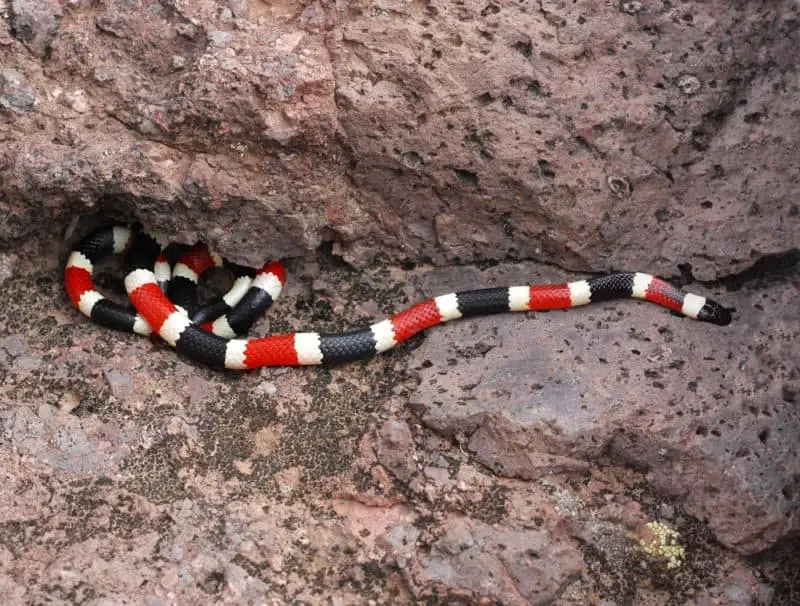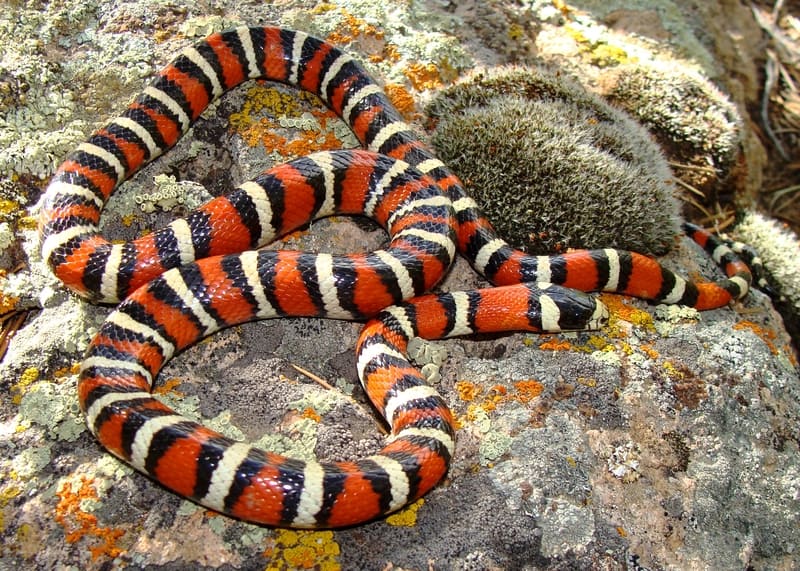When you’re in the outdoors, you have the safety net of civilization taken away from you. On a rare occasion, something bad can happen. When they do, you have only yourself to rely on. A venomous snake bite is one of those bad things. According to the CDC, 7 to 8,000 people in the U.S are bitten by venomous snakes each year. On an average year, five of those people will die. This article will inform you how to avoid snakebite and increase the odds that you will survive if you’re bitten by a venomous snake.
Dressing For Snake Country
There are no snakes in Alaska. There’s a reason for that. It’s too darned cold. On the other side of the coin, the warmer the climate, the better cold-blooded snakes like it. When you’re out in snake country, it’ll be mighty tempting to dress for the warm weather. Don’t do it.
- Ditch the shorts and flip flops in favor of high topped leather or rubber boots and heavy denim.
- Wear loose-fitting clothes. If there’s some space between your clothing and your skin, it decreases the chances a little bit that a striking snake’s fangs will reach and envenomate you.
- In the absence of high topped boots, some people opt. for wearing snake gaiters.
- Put your dogs in protective vests.
Be Aware Of Your Surroundings
It’s easy to become complacent, but in snake country, be especially vigilant about where you place your hands and feet. All it takes is a split second of distraction to place one of your limbs within a venomous snake’s strike zone.
If your traveling through dense undergrowth, using a walking stick is a good idea. Tap the ground in your route to give those poisonous serpents a bit of advance notice that you’re coming through. Also, use your walking stick to move any litter or foulage that obstructs your view of where you’re going to place your feet.
Remember, snakes are cold-blooded. They’ll be less active in the early morning hours. Snakes become sluggish anywhere below 60 degrees Fahrenheit.
If you’re staying overnight in snake country, pick a camping site in a clearing that is free of long grass if you have the option.
From my reading, I’ve learned that snakes are repelled by ammonia. I can’t guarantee the results, but it’s worth trying to spray ammonia around your campsite.
From the Mayo Clinic website, “Most snakes aren’t dangerous to humans. Only about 15% worldwide and 20% in the United States are venomous. In North America, these include the rattlesnake, coral snake, water moccasin, and copperhead. Their bites can cause severe injuries and sometimes death.” Source



How To Identify A Poisonous Snake
- In the case of a Rattlesnake, the buzzing sound is a dead give away. Rattlesnakes don’t always buzz before they bite, though.
- Copperheads, Water Moccasins, and Rattlesnakes are all Pit Vipers. Pit Vipers all have heat-seeking pit organs located on each side of their heads halfway between their eye and their nostril.
- Most Venomous Snakes in the U.S have heads that are large in proportion to their neck. Also, when you view a venomous snake’s head from above, it has a distinct triangular shape. On the other hand, nonvenomous snakes have more of a rounded head that is more proportionate to their neck size. An exception to this rule is the coral snake. Coral snakes have smaller, more rounded heads.
- With the exception of the coral snake, our poisonous snakes have thin vertical pupils in the U.S. On the other hand, along with the Coral Snake, in the United States, our non-venomous snakes have rounded pupils. If you’re close enough to a snake to examine its pupils, your a little too close, though.
- The venomous Coral Snake and the non-venomous King Snake both have yellow, red, and black bands. The difference between the two is that the red bands touch the yellow ones on the Coral Snake and the red bands touch the black bands on the King Snake. Source
How to Survive a Snake Bite
If you have adequate first aid treatment and receive antivenom in a timely manner, the chances of surviving a snake bite are pretty high. To requote the Center of Disease Control statistics that I shared at the beginning of the article, out of the 7,000 to 8,000 people bitten each year in the United States, around five will die. If you receive correct first aid and prompt medical treatment, your odds of survival are actually very good.
If Your Bitten
- First of all, get far enough away from the snake that it can’t bite you again.
- Remember that if you can remain calm and still, it will slow the spread of the venom.
- You need to remove any restrictive clothing or jewelry that might shut off circulation before you start to swell.
- Position the bite if possible so that it’s at or below the level of your heart.
- If you have it on hand, clean the wound with soap and water. Then cover it with a clean, dry dressing. Source
- A venomous snake bite is a medical emergency. If someone is available to drive you, have them get you to the hospital. At this point, do what will get you to medical treatment the quickest. If you don’t have a driver and don’t feel up to driving yourself, call an ambulance.
What Not To Do
- Do not place a tourniquet above or below the bite or apply ice to the bite area.
- Never cut into the wound or attempt to suck out the venom.
- Never drink caffeine or alcohol. These could speed your body’s absorption of venom.
- Don’t try to capture or kill the snake. This is a good way to get bitten again. Try to remember its color and shape so that you can describe it to medical personnel. This will help them prescribe the proper treatment. If you have a smartphone with you, and it won’t delay getting help, take a picture of the snake from a safe distance to help with identification. The above recommendations come from the Mayo Clinic. Source
If Your In The Back Country
Medical emergencies don’t always occur in the most ideal time or place. If you get bitten when you are away from any roads or out of cellular service, it will be up to you to save yourself.
You’ll still need to follow the above first aid advice. Then you’ll need to plot out the safest, fastest route to get help and make it happen. According to what I’ve read, time is of the essence, and sometimes it’s better to walk for help than to wait for help to find you. Source
This quote is from Snakebite.org concerning snakebite-triggered anaphylaxis. ” If you begin to experience signs of anaphylaxis (swelling of face, mouth, or throat; hives; difficulty breathing, etc.), use an epinephrine autoinjector (EpiPen or generic) if you have one and then take Benadryl and Zantac. If you don’t carry these things in the backcountry, you should do yourself a favor and get them because you can’t MacGyver an EpiPen out of nothing. Many things can cause anaphylaxis, and EpiPen can also be used as a last-ditch intervention for severe asthma attacks. Source
Don’t Let A Fear Of Venomous Snakes Keep You From Enjoying The Great Outdoors
We need to get away from the artificial sanctuaries we’ve made for ourselves from time to time and answer the call of the wild, so to speak. We need to remember how blue the sky is and what it’s like to breathe clear air.
When you are outdoors and surrounded by all the magnificence of God’s creation, you wonder why we go to such great lengths to put barriers between ourselves and the natural world or why we work so hard to tame it.
Encounters with venomous snakes are extremely rare, and envenomations are rarer still, so have no fear.
Using the advice given above will make the time you spend in poisonous snake country a little safer.
Venomous Snakes listed by State
- Alabama
- Alaska-no venomous snakes
- Arizona
- Arkansas
- California
- Colorado
- Connecticut
- Delaware
- Florida
- Georgia
- Hawaii-no venomous snakes
- Idaho
- Illinois
- Indiana
- Iowa
- Kansas
- Kentucky
- Louisiana
- Maine- There are no venomous snakes in Maine. The Timber Rattlesnake once lived there but has since been expatriated.
- Maryland
- Massachusetts
- Michigan
- Minnesota
- Mississippi
- Missouri
- Montana
- Nebraska
- Nevada
- New Hampshire
- New Jersey
- New Mexico
- New York
- North Carolina
- North Dakota
- Ohio
- Oklahoma
- Oregon
- Pennsylvania
- Rhode Island-no venomous snakes
- South Carolina
- South Dakota
- Tennessee
- Texas
- Utah
- Vermont
- Virginia
- Washington
- West Virginia
- Wisconsin
- Wyoming
Recent Posts
The only venomous snakes in Washington State are Northern Pacific Rattlesnakes. The Northern Pacific Rattlesnake (Crotalus oreganus oreganus) is a sub-species of the Western Rattlesnake. Anyone...
Skunks are not classified as true hibernators. But they go into a state of torpor when the weather gets cold. Skunks are light sleep hibernators, along with opossums, bears, and raccoons. ...

